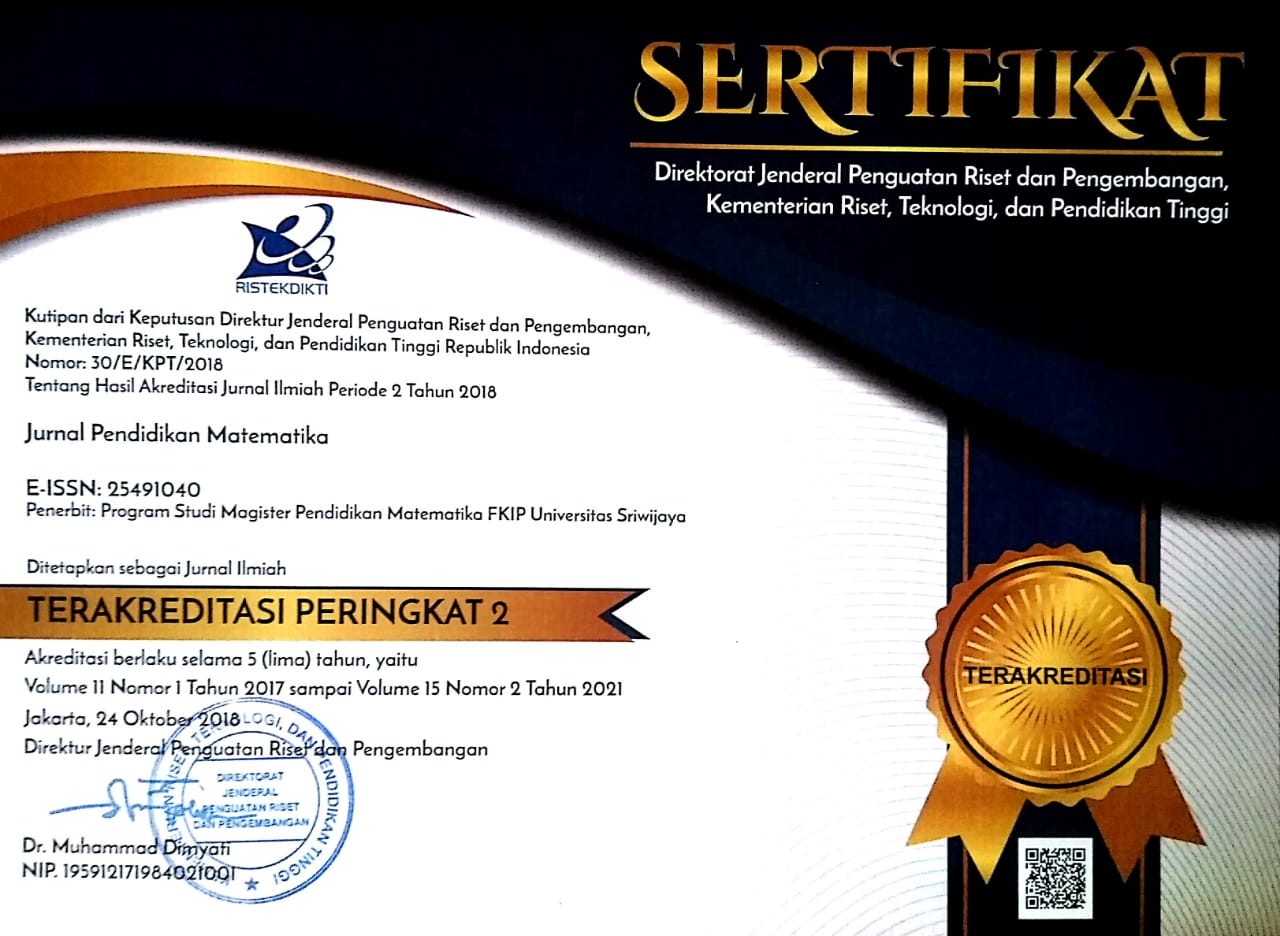Obstacles Faced by College Students in Solving Probability Word Problems
Abstract
There are many difficulties that can be identified when students solve mathematic problems especially in solving probability word problems. This study was conducted to identify the major obstacles faced by matriculation college students while solving the probability of an event word problems. Seven college students were the sample for this case study. Clinical interviews are used as a data collection. This data collection technique was selected based on the researcher’s observation on the participants as they answered the probability word problem task. The task was given during the interview session. Semi structured interviews are used to obtain in depth information. Think-aloud analysis involves observations leading to individual behaviours in the oral or nonverbal form of participants and the researcher’s field notes. Participants were found to have difficulty interpreting probabilities. There are three categories of difficulties that have been identified, namely not knowing the meaning of the word, not knowing the nature of the probability and not being able to identify the goal of the probability word problem.
Keywords
Full Text:
PDFReferences
Arum, D. P., Kusmayadi, T. A., & Pramudya, I. (2018). Students’ difficulties in probabilistic problem-solving. Journal of Physics: Conference Series, 983(1). https://doi.org/10.1088/1742-6596/983/1/012098.
Baltaci, S., & Evran, A. (2016). Examination of gifted students’ probability problem solving process in terms of mathematical thinking. Malaysian Online Journal of Educational Technology, (4).
Batanero, C., Chernoff, E. J., Engel, J., Lee, H. S., & Sánchez, E. (2016). Research on teaching and learning probability. Proceedings of the 12th International Congress on Mathematical Education. https://doi.org/10.1007/978-3-319-31625-3_1.
Beitzel, B. D., & Staley, R. K. (2015). The efficacy of using diagrams when solving probability word problems in college. Journal of Experimental Education, 83(1), 130–145. https://doi.org/10.1080/00220973.2013.876232.
Beitzel, B. D., Staley, R. K., & DuBois, N. F. (2011). When best intentions go awry: The failures of concrete representations to help solve probability word problems. Educational Research Quarterly, 34(3), 3–14. Retrieved from http://search.ebscohost.com/login.aspx?direct=true&db=eax&AN=59619869&site=ehost-live.
Bobek, E. J., & Corter, J. E. (2010). Effects of problem difficulty and student expertise on the utility of provided diagrams in probability problem solving. Proceedings of the Annual Meeting of the Cognitive Science Society, (vol. 32, pp. 276–281). https://doi.org/https://doi.org/ISBN 978-0-9768318-8-4.
Charles, R., Lester, F., & O’Daffer, P. (2005). How to Evaluate Progress in Problem Solving. National Council of Teachers of Mathematics.
Corter, J. E., & Zahner, D. C. (2007). Use of External Visual Representations in Probability Problem Solving. Statistics Education Research Journal, 6(1), 22-50.
Danisman, S., & Tanisli, D. (2017). Examination of mathematics teachers’ pedagogical content knowledge of probability. Malaysian Online Journal of Educational Sciences, 5(2), 16–34. Retrieved from http://libproxy.library.wmich.edu/login?url=https://search.proquest.com/docview/1913352728?accountid=15099.
Daroczy, G., Wolska, M., Meurers, W. D., & Nuerk, H. C. (2015). Word problems: A review of linguistic and numerical factors contributing to their difficulty. Frontiers in Psychology, 6, 1–13. https://doi.org/10.3389/fpsyg.2015.00348.
Gabriel, Y. (2002). Students’ difficulties and strategies in solving conditional probability problems with computational simulation. Journal of Chemical Information and Modeling, 53(9), 1689–1699. https://doi.org/10.1017/CBO9781107415324.004.
Gagatsis, A., & Elia, I. (2004). The effects of different modes of representation on mathematical problem solving. Proceedings of the 28th Conference of the International Group for the Psychology of Mathematics Education, 2, 447–454.
Galavotti, M. C. (2015). Probability theories and organization science: the nature and usefulness of different ways of treating uncertainty. Journal of Management, 41(2), 744–760. https://doi.org/10.1177/0149206314532951.
Gugga, S. S., & Corter, J. E. (2014). Effects of temporal and causal schemas on probability problem solving. Proceedings of the Annual Meeting of the Cognitive Science Society, (vol. 36, pp. 2321-2326). Retrieved from https://escholarship.org/uc/item/6jn7c43s.
Guven, B., & Cabakcor, B. O. (2013). Factors influencing mathematical problem-solving achievement of seventh grade Turkish students. Learning and Individual Differences, 23(1), 131–137. https://doi.org/10.1016/j.lindif.2012.10.003.
Inzunza, S. (2006). Student’s errors and difficulties for solving problems of sampling distributions by means of computer simulation. ICOTS-7, 1–4.
Kementerian Pendidikan Malaysia. (2013). Malaysia Education Blueprint 2013 - 2025. Malaysia Education Blueprint, Malaysia. https://doi.org/10.1016/j.tate.2010.08.007.
Kusdinar, U., Sukestiyarno, Isnarto, & Istiandaru, A. (2017). Krulik and Rudnik model Heuristic strategy in mathematics problem solving. International Journal on Emerging Mathematics Education, 1(2), 205–210. https://doi.org/http://dx.doi.org/10.12928/ijeme.v1i2.5708.
Ong, H. C., & Lim, J. S. (2014). Identifying factors influencing mathematical problem solving among matriculation students in Penang. Pertanika Journal, 22(3), 393–408.
Phonapichat, P., Wongwanich, S., & Sujiva, S. (2014). An analysis of elementary school students’ difficulties in mathematical problem solving. Procedia - Social and Behavioral Sciences, 116(2012), 3169–3174. https://doi.org/10.1016/j.sbspro.2014.01.728.
Schley, D. R., & Fujita, K. (2014). Seeing the math in the story: On how abstraction promotes performance on mathematical word problems. Social Psychological and Personality Science, 5(8), 953–961. https://doi.org/10.1177/1948550614539519.
Swensen, D. R. (2015). Mathematical identity and the use of high-leverage thinking moves during problem-solving activities. Dissertation. Minnesota: University of Minnesota.
Usry, R., Rosli, R., & Maat, S. M. (2016). An error analysis of matriculation students’ permutations and combinations. Indian Journal of Science and Technology, 9(4), 1–6. https://doi.org/10.17485/ijst/2016/v9i2/81793.
Von Glasersfeld, E. (2002). Radical Constructivism in Mathematics Education. Dordrecht: Kluwer Academic Publishers (Vol. 7). https://doi.org/10.1017/CBO9781107415324.004.
Xing, C. (2016). Effects of diagrams on strategy choice in probability problem solving. Dissertation. New York: Columbia University.
Yusof, K., & Taib, H. (2006). Mathematics problem solving involving surd equations. In Seminar Penyelidikan Martikulasi Ministry of Education Malaysia.
Yusoff, N., & Salleh, I. (2006). Problem solving skills in probability among matriculation students. In Seminar Penyelidikan Pendidikan Kebangsaan XIII (pp. 40–55).
Zahner, D., & Corter, J. E. (2010). The process of probability problem solving: Use of external visual representations. Mathematical Thinking and Learning, 12(2), 177–204. https://doi.org/10.1080/10986061003654240.
Zakaria, E., & Yusoff, N. (2009). Attitudes and problem-solving skills in algebra among malaysian matriculation college students. European Journal of Social Sciences, 8, 232–245.
DOI: https://doi.org/10.22342/jpm.15.1.12801.83-90
Jl. Srijaya Negara, Bukit Besar
Palembang - 30139 Indonesia
Jurnal Pendidikan Matematika is licensed under a Creative Commons Attribution-NonCommercial-ShareAlike 4.0 International License.
Indexed in:


